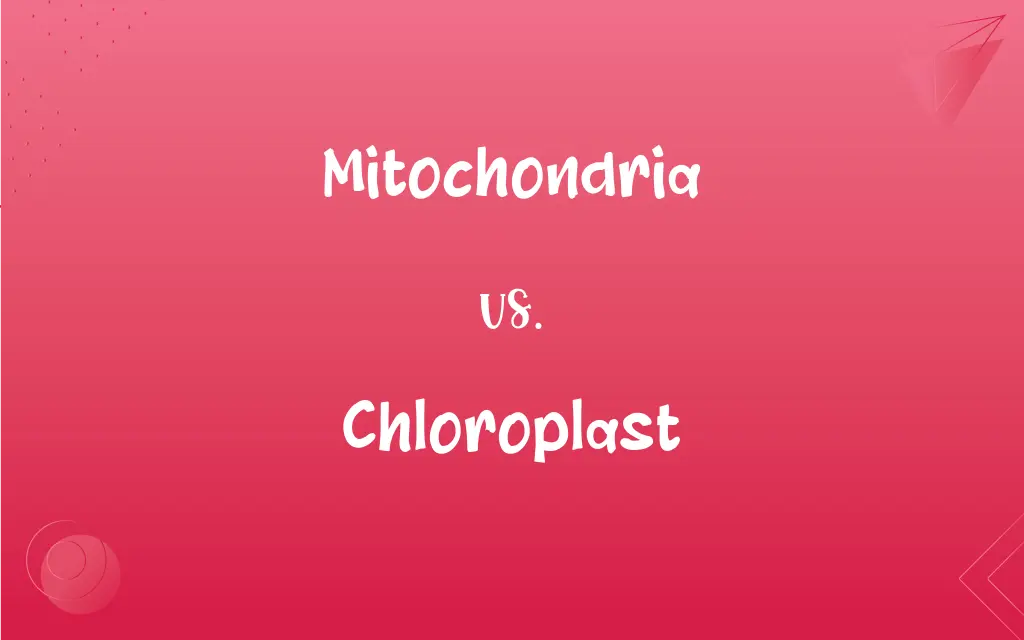Mitochondria vs. Chloroplast: What's the Difference?
Edited by Aimie Carlson || By Harlon Moss || Updated on October 28, 2023
Mitochondria are cell organelles producing energy, while chloroplasts are organelles in plants and algae aiding in photosynthesis.

Key Differences
Mitochondria are found in almost all eukaryotic cells, including those of animals, plants, and fungi, and they primarily function in energy production through cellular respiration. In contrast, chloroplasts are specific to plant cells and certain algae, where they facilitate photosynthesis, converting sunlight into chemical energy. Mitochondria are known as the "powerhouses" of the cell, generating ATP (adenosine triphosphate), while chloroplasts are often referred to as the "kitchens" of the cell, synthesizing sugars. Despite their differences, both organelles are essential for energy management within cells.
Structurally, mitochondria are characterized by their unique double membrane and inner folds called cristae, which increase the surface area for ATP production. Chloroplasts also possess a double membrane but contain internal structures known as thylakoids, organized into stacks called grana, where the light-dependent reactions of photosynthesis occur. Mitochondria’s structure is optimized for cellular respiration processes, whereas chloroplasts are designed for capturing and converting light energy. Both organelles, despite their different structures, are integral to the cell's overall function.
Regarding evolutionary origins, mitochondria are believed to have evolved from engulfed proteobacteria, while chloroplasts likely originated from engulfed cyanobacteria, a theory known as the endosymbiotic theory. Both mitochondria and chloroplasts possess their own DNA, circular and similar to bacterial DNA, reflecting their evolutionary history. While mitochondria are involved in various cellular processes, including ATP production and regulation of apoptosis, chloroplasts are primarily engaged in photosynthesis and related biosynthetic pathways. This evolutionary divergence has led to the specialization of each organelle in distinct but vital cellular functions.
In terms of energy transformation, mitochondria play a crucial role in converting the energy stored in food molecules into usable cellular energy in the form of ATP, a process dependent on oxygen and known as aerobic respiration. Chloroplasts, on the other hand, capture light energy and use it to convert carbon dioxide and water into glucose and oxygen, a process known as photosynthesis. While mitochondria are central to energy utilization in cells, chloroplasts are fundamental to energy capture and conversion. Despite their different roles in energy dynamics, both organelles are indispensable for the survival and functioning of eukaryotic cells.
Comparison Chart
Primary Function
Energy production through cellular respiration.
Photosynthesis, converting light to chemical energy.
ADVERTISEMENT
Location
Present in most eukaryotic cells.
Found in plant cells and algae.
Origin
Evolved from endosymbiotic bacteria.
Also evolved from endosymbiotic bacteria.
DNA
Have their own DNA.
Contain their own DNA.
Additional Functions
Involved in apoptosis and calcium signaling.
Synthesize some amino acids and fatty acids.
Mitochondria and Chloroplast Definitions
Mitochondria
Mitochondria convert nutrients into ATP.
Mitochondria are crucial for ATP synthesis during intense exercise.
ADVERTISEMENT
Chloroplast
Convert light energy into chemical energy.
The chloroplasts in leaves are essential for converting sunlight into energy.
Mitochondria
They are the site of cellular respiration in cells.
Oxygen is consumed by mitochondria during cellular respiration.
Chloroplast
Have their own DNA, distinct from the cell's nucleus.
Chloroplasts inherit their DNA maternally in most plants.
Mitochondria
Possess their own DNA, separate from the cell's nucleus.
The mitochondria inherited from the mother have unique DNA.
Chloroplast
They contain the pigment chlorophyll.
The green color of leaves is due to chlorophyll in chloroplasts.
Mitochondria
Play a role in programmed cell death, or apoptosis.
The release of certain proteins from mitochondria triggers apoptosis.
Chloroplast
Chloroplasts are organelles in plants for photosynthesis.
Chloroplasts capture sunlight to produce food for the plant.
Mitochondria
Mitochondria are cell organelles responsible for energy production.
The mitochondria in muscle cells are abundant to meet high energy demands.
Chloroplast
Involved in synthesizing amino acids and fatty acids.
Chloroplasts contribute to the synthesis of essential fatty acids.
Mitochondria
A spherical or elongated organelle in the cytoplasm of nearly all eukaryotic cells, conning genetic material and many enzymes important for cell metabolism, including those responsible for the conversion of food to usable energy.
Chloroplast
A plastid that contains chlorophyll and is found in the cells of green plants and algae.
Mitochondria
Plural of mitochondrion
Muscles contain many mitochondria so that they can have large energy supplies.
FAQs
What is the main function of mitochondria?
Their main function is to generate ATP through cellular respiration.
What are chloroplasts?
Chloroplasts are organelles in plants and algae that perform photosynthesis.
What are mitochondria?
Mitochondria are organelles in cells that produce energy.
Do chloroplasts contain DNA?
Yes, chloroplasts also have their own DNA.
Which cells have chloroplasts?
Plant cells and algae contain chloroplasts.
What is the primary role of chloroplasts?
The primary role is to carry out photosynthesis.
How do mitochondria help in energy production?
They convert nutrients into ATP, the cell's energy currency.
Do mitochondria have their own DNA?
Yes, mitochondria have their own DNA.
Where are mitochondria found?
They are found in most eukaryotic cells.
How do chloroplasts contribute to a plant’s energy?
They convert sunlight into glucose, providing energy for the plant.
What is the endosymbiotic theory related to these organelles?
It suggests that both evolved from endosymbiotic bacteria.
What else do chloroplasts do besides photosynthesis?
They're involved in synthesizing some amino acids and fatty acids.
Are mitochondria inherited from both parents?
Typically, they are maternally inherited.
Are chloroplasts found in all parts of a plant?
They're mainly in the green parts, like leaves.
Are chloroplasts present in animal cells?
No, chloroplasts are not present in animal cells.
Can mitochondria be involved in cell death?
Yes, they play a role in apoptosis, or programmed cell death.
How do chloroplasts affect the color of plants?
The chlorophyll in chloroplasts gives plants their green color.
Do all cells have the same number of mitochondria?
No, the number varies depending on the cell's energy needs.
Can the number of chloroplasts in a cell change?
Yes, it can change based on environmental factors like light.
Can mitochondria be found in plant cells?
Yes, plant cells contain mitochondria.
About Author
Written by
Harlon MossHarlon is a seasoned quality moderator and accomplished content writer for Difference Wiki. An alumnus of the prestigious University of California, he earned his degree in Computer Science. Leveraging his academic background, Harlon brings a meticulous and informed perspective to his work, ensuring content accuracy and excellence.
Edited by
Aimie CarlsonAimie Carlson, holding a master's degree in English literature, is a fervent English language enthusiast. She lends her writing talents to Difference Wiki, a prominent website that specializes in comparisons, offering readers insightful analyses that both captivate and inform.
































































